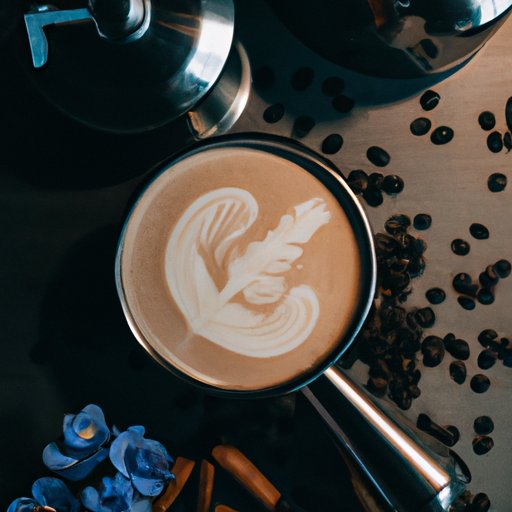I. Introduction
Do you find yourself struggling to make the perfect cappuccino? Perhaps the milk doesn’t froth correctly, or the espresso doesn’t complement the milk properly. Fear not, as this article aims to provide a comprehensive guide on how to make an authentic cappuccino. From basic equipment and ingredients to customization and fun facts, we cover it all.
II. A Step-by-Step Guide on How to Make a Classic Cappuccino with Basic Equipment and Ingredients
Before getting into the specifics, let’s go over the basic equipment and ingredients needed for making a cappuccino:
- Espresso machine
- Milk frother
- Espresso beans
- Whole milk
Here’s the step-by-step process for making the perfect cappuccino:
- Start by brewing a shot of espresso into a cappuccino cup.
- Pour cold whole milk into the milk frother pitcher. Make sure not to fill the pitcher beyond the recommended line.
- Submerge the steam wand into the pitcher and turn on the frother. Hold the pitcher at an angle so that the steam wand is just below the milk’s surface.
- Froth the milk until the volume doubles. Tap the pitcher against a flat surface to remove any large bubbles, then swirl the milk to create a smooth and velvety texture.
- Pour the frothed milk into the cup of espresso, holding back some of the foam with a spoon to create a distinct separation between the milk and foam.
And voila, a classic cappuccino.
III. Tips and Tricks for Frothing Milk to Create Perfectly Steamed Milk for Cappuccinos
Properly frothing the milk is crucial to the cappuccino’s overall taste and texture. Here are some tips and tricks for achieving perfectly steamed milk:
- Use cold and fresh whole milk
- Make sure the steam wand is submerged deep enough into the milk for maximum froth creation
- Avoid overheating the milk, as it can burn and create a sour taste
Common mistakes to avoid when frothing milk include overheating the milk, not frothing the milk enough, and not tapping the pitcher to remove large bubbles.
IV. Choosing the Right Coffee Beans for Cappuccino and Recommending Some Popular Options
The coffee beans used in a cappuccino have a significant impact on the final taste. We recommend choosing espresso beans with a bold and rich flavor. Here are some popular coffee bean options for cappuccino:
- Illy Medium Roast Espresso Beans
- Lavazza Super Crema Espresso Beans
- Caribou Coffee Caribou Blend Espresso Beans
When selecting the best coffee beans for cappuccino, consider your preferred taste and flavor notes you enjoy.
V. Detailed Explanation of the Difference Between Cappuccino and Latte, and How to Customize Your Cappuccino Based on Your Preferences
It’s important to note the difference between a cappuccino and a latte. While both contain espresso and milk, a cappuccino has more foam and less milk than a latte. If you prefer a stronger coffee flavor, opt for a cappuccino. For a sweeter and creamier taste, try a latte.
You can further customize your cappuccino by adding flavor syrups, chocolate powder, or cinnamon to spice things up. Experiment with different amounts of milk and foam to create your perfect taste.
VI. Highlighting the Significance of the Temperature, Texture, and Proportion of Espresso and Milk for a Balanced Cappuccino
The temperature, texture, and proportion of espresso and milk all contribute to a balanced cappuccino. The espresso shot should be hot and strong, while the milk should be velvety and glossy. The ideal foam-to-milk ratio for a cappuccino is 1:1, creating a distinct separation between milk and froth.
VII. Suggesting Some Creative and Tasty Alternatives to Classic Cappuccinos, Such as Flavored Cappuccinos or Non-Dairy Options
If you’re looking for something different from a classic cappuccino, there are plenty of flavored and non-dairy options to try. Some popular alternatives include:
- Hazelnut or Vanilla Cappuccino
- Iced Cappuccino
- Coconut Milk Cappuccino
To make a flavored cappuccino, add your desired flavor syrup to the espresso shot before frothing the milk. For a non-dairy option, use almond, soy, or coconut milk instead of whole milk.
VIII. Sharing Some Fun and Interesting Facts About Cappuccino, Including Its Origin, Historical Significance, and Cultural Impact
Did you know that the cappuccino originated in Italy in the 1900s? Cappuccino is named after the Capuchin monks, who wore brown hoods that resemble the drink’s color. In Italy, cappuccino is typically only consumed in the morning and never after a meal. In the United States, it’s a popular drink choice throughout the day.
Cappuccino has also made a significant impact on pop culture, appearing in films, books, and television shows. Its cultural significance has cemented cappuccino’s place as a beloved staple in the coffee world.
IX. Conclusion
In conclusion, making the perfect cappuccino requires a little bit of effort and knowledge. From frothing milk to choosing the right coffee beans, every step contributes to the overall taste and experience. Remember to experiment and customize your cappuccino based on your preferences and enjoy a delicious and authentic cup of coffee.
Key takeaways from this article include the importance of properly frothing milk, choosing the right coffee beans, and understanding the difference between cappuccino and latte.
